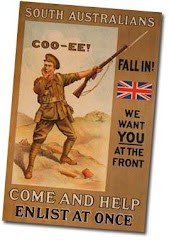 Alf Sinigear was the only son of Thomas George Wintle Sinigear and Ellen Sinigear (nee Rowe) of Blackwood. He was born at Norwood in 1897, and was educated at Coromandel Valley Public School and at the Adelaide High School in Grote Street, Adelaide. He served in the senior cadets for three years with the 76th Battalion and after his schooling worked as a clerk for Elder, Smith & Co. Before the war he was active in the Blackwood, Belair and Coromandel Boys’ Club, including its literary society and basketball team, and he was also secretary of the Blackwood Football Club 2nd XVIII and played for the Coromandel 2nd XI cricket team. He was also a local athlete of note.
Alf Sinigear was the only son of Thomas George Wintle Sinigear and Ellen Sinigear (nee Rowe) of Blackwood. He was born at Norwood in 1897, and was educated at Coromandel Valley Public School and at the Adelaide High School in Grote Street, Adelaide. He served in the senior cadets for three years with the 76th Battalion and after his schooling worked as a clerk for Elder, Smith & Co. Before the war he was active in the Blackwood, Belair and Coromandel Boys’ Club, including its literary society and basketball team, and he was also secretary of the Blackwood Football Club 2nd XVIII and played for the Coromandel 2nd XI cricket team. He was also a local athlete of note.He enlisted on 28 June 1915 at the age of 18, and embarked with Ack Company of the 32nd Battalion in November that year. After training in the Middle East, during which Alf was ill several times, the battalion shipped out to France in June 1916. The 32nd Battalion, as part of the 8th Brigade of the 5th Division, fought its first major battle at Fromelles on 19 July 1916, having entered the front line only a few days prior. It was also the first attack conducted by Australian troops on the Western Front. The attack was a disaster, with the battalion suffering nearly 75% casualties in the worst night in the history of the Australian Army. One of those casualties was Alf Sinigear, whose body could not be located after the battle, and as a result he was recorded as killed in action. Along with 1,332 other Australians who died in the battle who had no known grave, his name was inscribed on the VC Corner Australian Memorial at Fromelles. Despite the efforts of the recent Fromelles Project, his remains have yet to be identified, although it is possible he was amongst those re-interred in the Pheasant Wood Cemetery in 2010.
Alf Sinigear's name is also inscribed on the Blackwood Memorial, the honour board in the Elders Building in Currie Street, Adelaide, and the South Australian National War Memorial, North Terrace.
Alf was the only son of an only son, and his death, along with that of his father in November that year, meant that the name Sinigear died out in Australia with the death of his mother in 1938.
Photograph: The Advertiser, 18 August 1916, page 7.































